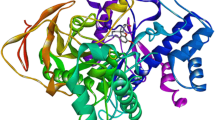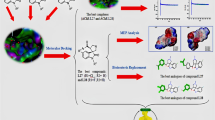Abstract
Pharmacological studies from our group [Lima et al. Pharmacol Biochem Behav 92:508, (2009)] revealed that geissospermine (GSP), the major alkaloid of the bark extract of Brazilian Geissospermum vellosii, inhibits acetylcholinesterases (AChEs) in the brains of rats and electric eels (Electrophorus electricus). However, the binding mode (i.e., conformation and orientation) of this indole-indoline alkaloid into the AChE active site is unknown. Therefore, in order to propose a plausible binding mode between GSP and AChE, which might explain the observed experimental inhibitory activity, we performed comparative automatic molecular docking simulations using the AutoDock and Molegro Virtual Docker (MVD) programs. A sample of ten crystal structures of the Pacific electric ray (Torpedo californica) TcAChE, in complex with ten diverse active site ligands, was selected as a robust re-docking validation test, and also for GSP docking. The MVD results indicate a preferential binding mode between GSP and AChE, in which GSP functional groups may perform specific interactions with residues in the enzyme active site, according to the ligand–protein contacts detected by the LPC/CSU server. Four hydrogen bonds were detected between GSP and Tyr121, Ser122, Ser200, and His440, in which the last two residues belong to the catalytic triad (Ser200···His440···Glu327). Hydrophobic and π–π stacking interactions were also detected between GSP and Phe330 and Trp84, respectively; these are involved in substrate stabilization at the active site. This study provides the basis to propose structural changes to the GSP structure, such as molecular simplification and isosteric replacement, in order to aid the design of new potential AChE inhibitors that are relevant to the treatment of Alzheimer’s disease.

GSP/1DX6 (Molegro Virtual Docker)





Similar content being viewed by others
References
Alcala MDM, Vivas NM, Hospital S, Camps P, Munoz-Torrero D, Badia A (2003) Characterisation of the anticholinesterase activity of two new tacrine-huperzine A hybrids. Neuropharmacol 44:749–755
Cutler NR, Sramek JJ (2001) Review of the next generation of Alzheimer’s disease therapeutics: challenges for drug development. Prog Neuro-Psychopharmacol Biol Psychiatry 25:27–57
Ginsberg SD, Che S, Counts SE, Mufson EJ (2006) Single cell gene expression profiling in Alzheimer’s disease. NeuroRx 3:302–318
Bertram L, Busch R, Spiegl M, Lautenschlager NT, Muller U, Kurz A (1998) Paternal age is a risk factor for Alzheimer disease in the absence of a major gene. Neurogenet 1:277–280
Tsai MS, Tangalos EG, Petersen RC, Smith GE, Schaid DJ, Kokmen E, Ivnik RJ, Thibodeau SN (1994) Apolipoprotein-E: risk factor for Alzheimer-disease. Am J Hum Genet 54:643–649
Fleminger S (2003) Head injury as a risk factor for Alzheimer’s disease. J Neurol Neurosurg Psychiatry 74:857–862
Martins IJ, Hone E, Foster JK, Sunram-Lea SI, Gnjec A, Fuller SJ, Nolan D, Gandy SE, Martins RN (2006) Apolipoprotein E, cholesterol metabolism, diabetes, and the convergence of risk factors for Alzheimer’s disease and cardiovascular disease. Mol Psychiatry 11:721–736
Kivipelto M, Laakso MP, Tuomilehto J, Nissinen A, Soininen H (2002) Hypertension and hypercholesterolaemia as risk factors for Alzheimer’s disease—potential for pharmacological intervention. CNS Drugs 16:435–444
Kivipelto M, Solomon A (2006) Cholesterol as a risk factor for Alzheimer’s disease—epidemiological evidence. Acta Neurol Scand 114:50–57
De la Torre JC (2006) How do heart disease and stroke become risk factors for Alzheimer’s disease? Neurol Res 28:637–644
Anstey KJ, von Sanden C, Salim A, O’Kearney R (2007) Smoking as a risk factor for dementia and cognitive decline:a meta-analysis of prospective studies. Am J Epidemiol 166:367–378
Mebane-Sims I (2009) 2009 Alzheimer’s disease facts and figures. Alzheimers Dementia 5:234–270
Schmidt R, Assem-Hilger E, Benke T, Dal-Bianco P, Delazer M, Ladurner G, Jellinger K, Marksteiner J, Ransmayr G, Schmidt H, Stögmann E, Wancata J, Wehringer C (2008) Sex differences in Alzheimer’s disease. Neuropsychiatrie 22:1–15
Hebert LE, Scherr PA, McCann JJ, Beckett LA, Evans DA (2001) Is the risk of developing Alzheimer’s disease greater for women than for men? Am J Epidemiol 153:132–136
Patwardhan MB, McCrory DC, Matchar DB, Samsa GP, Rutschmann OT (2004) Alzheimer disease: operating characteristics of PET—a meta-analysis. Radiol 273:73–80
Mohs RC (2005) The clinical syndrome of Alzheimer’s disease: aspects particularly relevant to clinical trials. Genes Brain Behavior 4:129–133
Brookmeyer R, Johnson E, Ziegler-Graham K, Arrighi HM (2007) Forecasting the global burden of Alzheimer’s disease. Alzheimers Dementia 3:186–191
Scarpini E, Scheltens P, Feldman H (2003) Treatment of Alzheimer’s disease: current status and new perspectives. Lancet Neurol 2:539–547
Bartus RT, Dean RL, Beer B, Lippa AS (1982) The cholinergic hypothesis of geriatric memory dysfunction. Science 217:408–417
Francis PT, Palmer AM, Snape M, Wilcock GK (1999) The cholinergic hypothesis of Alzheimer’s disease: a review of progress. J Neurol Neurosurg Psychiatry 66:137–147
Cummings JL, Kaufer D (1996) Neuropsychiatric aspects of Alzheimer’s disease: the cholinergic hypothesis revisited. Neurol 47:876–883
Perry EK (1986) The cholinergic hypothesis—10 years on. Br Med Bull 42:63–69
Lleo A, Greenberg SM, Growdon JH (2006) Current pharmacotherapy for Alzheimer’s disease. Annu Rev Med 57:513–533
von Eschenbach AC (2007) Alzheimer’s disease: FDA’s role in new product development. http://www.fda.gov/NewsEvents/Testimony/ucm110879.htm. Accessed September 2010
Farlow MR, Cummings JL (2007) Effective pharmacologic management of Alzheimer’s disease. Am J Med 120:388–397
Cummings JL (2000) Cholinesterase inhibitors: a new class of psychotropic compounds. Am J Psychiatry 157:4–15
Rogers SL, Farlow MR, Doody RS, Mohs R, Friedhoff LT, Albala B, Baumel B, Booker G, Dexter J, Farmer M, Feighner JP, Ferris S, Gordon B, Gorman DG, Hanna G, Harrell LE, Hubbard R, Kennedy J, McCarthy J, Scharre DW, Schaerf F, Schneider L, Seltzer B, Siegal A, Stark SR, Strauss A, Walshe TM (1998) A 24-week, double-blind, placebo-controlled trial of donepezil in patients with Alzheimer’s disease. Neurol 50:136–145
Tariot PN, Solomon PR, Morris JC, Kershaw P, Lilienfeld S, Ding C (2000) A 5-month, randomized, placebo-controlled trial of galantamine in AD. Neurol 54:2269–2276
Findeis MA (2007) The role of amyloid beta peptide 42 in Alzheimer’s disease. Pharmacol Ther 116:266–286
Shen LL, Liu GX, Tang Y (2007) Molecular docking and 3D-QSAR studies of 2-substituted 1-indanone derivatives as acetylcholinesterase inhibitors. Acta Pharmacol Sin 28:2053–2063
Marco-Contelles J, Carreiras MD, Rodriguez C, Villarroya M, Garcia AG (2006) Synthesis and pharmacology of galantamine. Chem Rev 106:116–133
Sugimoto H, Yamanishi Y, Iimura Y, Kawakami Y (2000) Donepezil hydrochloride (E2020) and other acetylcholinesterase inhibitors. Curr Med Chem 7:303–339
Lima JA (2005) Isolamento e Identificação da Geissospermina, o Alcalóide Responsável pela Atividade Anticolinesterásica do Extrato do Geissospermum vellosii (thesis). Universidade Federal do Rio de Janeiro, Rio de Janeiro
Lima JA, Costa RS, Epifânio RA, Castro NG, Rocha MS, Pinto AC (2009) Geissospermum vellosii stembark: anticholinesterase activity and improvement of scopolamine-induced memory deficits. Pharmacol Biochem Behavior 92:508–513
Xu YC, Colletier JP, Weik M, Jiang HL, Moult J, Silman I, Sussman JL (2008) Flexibility of aromatic residues in the active-site gorge of acetylcholinesterase: X-ray versus molecular dynamics. Biophys J 95:2500–2511
Kryger G, Silman I, Sussman JL (1998) Three-dimensional structure of a complex of E2020 with acetylcholinesterase from Torpedo californica. J Physiol Paris 92:191–194
Berman HM, Westbrook J, Feng Z, Gilliland G, Bhat TN, Weissig H, Shindyalov IN, Bourne PE (2000) The Protein Data Bank. Nucleic Acids Res 28:235–242
Harel M, Schalk I, Ehretsabatier L, Bouet F, Goeldner M, Hirth C, Axelsen PH, Silman I, Sussman JL (1993) Quaternary ligand-binding to aromatic residues in the active-site gorge of acetylcholinesterase. Proc Nat Acad Sci USA 90:9031–9035
Greenblatt HM, Kryger G, Lewis T, Silman I, Sussman JL (1999) Structure of acetylcholinesterase complexed with (−)-galanthamine at 2.3 angstrom resolution. FEBS Lett 463:321–326
Felder CE, Harel M, Silman I, Sussman JL (2002) Structure of a complex of the potent and specific inhibitor BW284C51 with Torpedo californica acetylcholinesterase. Acta Crystallogr Sect D 58:1765–1771
Kryger G, Silman I, Sussman JL (1999) Structure of acetylcholinesterase complexed with E2020 (Aricept®): implications for the design of new anti-Alzheimer drugs. Structure 7:297–307
Bartolucci C, Perola E, Cellai L, Brufani M, Lamba D (1999) “Back door” opening implied by the crystal structure of a carbamoylated acetylcholinesterase. Biochem 38:5714–5719
Harel M, Hyatt JL, Brumshtein B, Morton CL, Yoon KJP, Wadkins RM, Silman I, Sussman JL, Potter PM (2005) The crystal structure of the complex of the anticancer prodrug 7-ethyl-10-[4-(1-piperidino)-1-piperidino]carbonyloxycamptothecin (CPT-11) with Torpedo californica acetylcholinesterase provides a molecular explanation for its cholinergic action. Mol Pharmacol 67:1874–1881
Raves ML, Harel M, Pang YP, Silman I, Kozikowski AP, Sussman JL (1997) Structure of acetylcholinesterase complexed with the nootropic alkaloid, (−)-huperzine A. Nat Struct Biol 4:57–63
Ravelli RBG, Raves ML, Ren Z, Bourgeois D, Roth M, Kroon J, Silman I, Sussman JL (1998) Static Laue diffraction studies on acetylcholinesterase. Acta Crystallogr Sect D 54:1359–1366
ACD/Labs (2009) ACD/ChemSketch Freeware, version 12.00. Advanced Chemistry Development. Inc., Toronto
Chiaroni A, Riche C (1979) Structure and stereochemistry of indole alkaloids. 5. Structure of geissospermine. Acta Crystallogr Sect B 35:1820–1825
Allen FH (2002) The Cambridge Structural Database: a quarter of a million crystal structures and rising. Acta Crystallogr Sect B 58:380–388
Tripos Inc. (2008) Website. http://tripos.com/
Gasteiger J, Marsili M (1980) Iterative partial equalization of orbital electronegativity—a rapid access to atomic charges. Tetrahedron 36:3219–3228
Clark M, Cramer RD, Vanopdenbosch N (1989) Validation of the general-purpose Tripos 5.2 force-field. J Comput Chem 10:982–1012
Morris GM, Goodsell DS, Halliday RS, Huey R, Hart WE, Belew RK, Olson AJ (1998) Automated docking using a Lamarckian genetic algorithm and an empirical binding free energy function. J Comput Chem 19:1639–1662
Thomsen R, Christensen MH (2006) MolDock: a new technique for high-accuracy molecular docking. J Med Chem 49:3315–3321
Teixeira C, Barbault F, Rebehmed J, Liu K, Xie L, Lu H, Jiang S, Fan B, Maurel F (2008) Molecular modeling studies of N-substituted pyrrole derivatives—potential HIV-1 gp41 inhibitors. Bioorg Med Chem 16:3039–3048
Mashhadi HR, Shanechi HM, Lucas C (2003) A new genetic algorithm with Lamarckian individual learning for generation scheduling. IEEE Trans Power Syst 18:1181–1186
Sobolev V, Sorokine A, Prilusky J, Abola EE, Edelman M (1999) Automated analysis of interatomic contacts in proteins. Bioinf 15:327–332
Storn R, Price K (1997) Differential evolution—a simple and efficient heuristic for global optimization over continuous spaces. J Global Optim 11:341–359
Thomsen R (2003) Flexible ligand docking using differential evolution. In: 2003 Congr on Evolutionary Computation, Canberra, Australia, 8–12 Dec 2003, pp 2354–2361
Gilson MK, Straatsma TP, McCammon JA, Ripoll DR, Faerman CH, Axelsen PH, Silman I, Sussman JL (1994) Open “back door” in a molecular-dynamics simulation of acetylcholinesterase. Science 263:1276–1278
Axelsen PH, Harel M, Silman I, Sussman JL (1994) Structure and dynamics of the active-site gorge of acetylcholinesterase—synergistic use of molecular-dynamics simulation and X-ray crystallography. Protein Sci 3:188–197
Jeffrey GA (1997) An introduction to hydrogen bonding. Oxford University Press, New York
Acknowledgments
We gratefully acknowledge the financial support provided by Brazilian governmental agencies: CNPq (Conselho Nacional de Desenvolvimento Científico e Tecnológico), CAPES (Coordenação de Aperfeiçoamento de Pessoal de Nível Superior), and FAPERJ (Fundação de Amparo à Pesquisa do Estado do Rio de Janeiro).
Author information
Authors and Affiliations
Corresponding authors
Electronic supplementary material
Below are the links to the electronic supplementary material.
Figure S1
Chemical 2D structures of the ten ligands (ligand name, ligand PDB ID) complexed with the ten Torpedo californica AChEs listed by the AChE PDB IDs (DOC 73 kb)
Table S1
Best docking poses (sorted by total energy) of the GSP into the Torpedo californica AChE obtained using the AutoDock program (DOC 37 kb)
Table S2
Best docking poses (sorted by total and Re-Rank energy values) of the GSP into the Torpedo californica AChE obtained using the Molegro Virtual Docker program (DOC 36 kb)
Rights and permissions
About this article
Cite this article
Araújo, J.Q., Lima, J.A., Pinto, A.C. et al. Docking of the alkaloid geissospermine into acetylcholinesterase: a natural scaffold targeting the treatment of Alzheimer’s disease. J Mol Model 17, 1401–1412 (2011). https://doi.org/10.1007/s00894-010-0841-2
Received:
Accepted:
Published:
Issue Date:
DOI: https://doi.org/10.1007/s00894-010-0841-2




